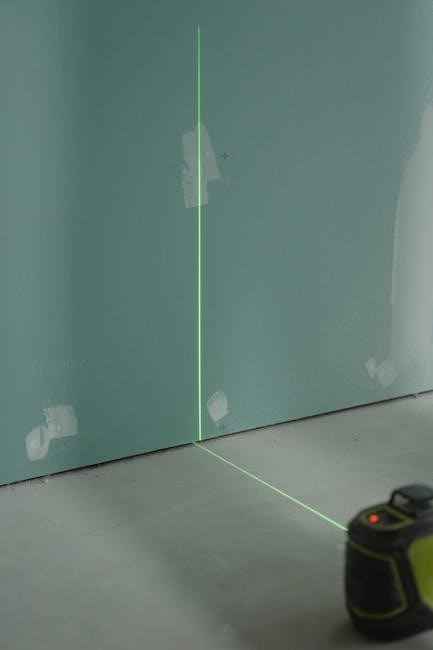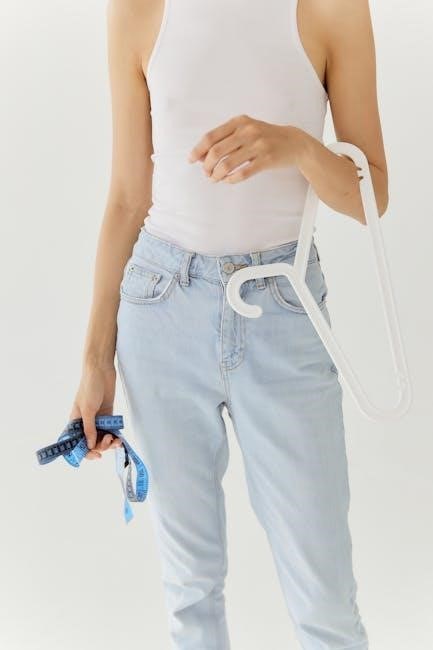Mastering the art of jean measurements ensures a perfect fit, boosts shopping confidence, and reduces returns. This guide simplifies the process, helping you find your ideal pair effortlessly.
Importance of Accurate Jean Measurements
Importance of Accurate Jean Measurements
Accurate jean measurements are crucial for ensuring a comfortable and flattering fit. Proper measurements help eliminate sizing guesswork, especially since brands often vary in their sizing standards. By taking precise body and jean measurements, you can avoid ill-fitting pairs, reduce returns, and shop confidently online or in-store. This guide provides a step-by-step approach to measuring correctly, ensuring your jeans complement your body type and personal style. Whether you’re shopping for new jeans or assessing your current collection, accurate measurements are key to achieving the perfect fit.
Purpose of the Guide
This guide is designed to empower you with the knowledge to measure jeans accurately, ensuring a perfect fit every time. By providing clear, step-by-step instructions, it helps you understand how to take precise body and jean measurements. Whether you’re shopping online or in-store, this guide equips you with the tools to avoid ill-fitting jeans and reduce returns. Its purpose is to simplify the process of finding your ideal pair, offering practical techniques to help you shop confidently and enjoy a seamless denim shopping experience.

Gathering Necessary Tools
A flexible tape measure and a full-length mirror are essential for accurate jean measurements. These tools ensure precise body and jean sizing, making the process straightforward and efficient.
What You Need to Measure Your Jeans
What You Need to Measure Your Jeans
To measure your jeans accurately, you’ll need a flexible tape measure, a flat surface, and a full-length mirror. Place the jeans flat on the surface, smoothing out wrinkles. Measure the waist by doubling the distance across the back. For hips, measure 7 inches below the waistline. Inseam is from the crotch to the hem. Use a notebook to record measurements for easy reference. Ensure the tape is snug but not tight for precise sizing. This setup guarantees accurate results, helping you find the perfect fit every time.
How to Use a Tape Measure Correctly
How to Use a Tape Measure Correctly
Using a tape measure correctly is key to accurate jean measurements. Ensure the tape is snug but not tight, lying flat against the body. For waist measurements, position the tape at your natural waistline, typically where your belly button is. Avoid measuring over bulky clothing. For hips, measure 7 inches below the waistline, keeping the tape level and parallel to the floor. Inseam is measured from the crotch to the ankle. Always take measurements in front of a mirror to ensure the tape is straight and properly aligned for precise results.

Key Body Measurements for Jeans
Key measurements include waist, hips, inseam, and thigh. Accurate measurements ensure the perfect fit, comfort, and style for your jeans.
Measuring Your Natural Waist
Measuring Your Natural Waist
To measure your natural waist, locate the smallest point above your hips, typically where your body bends. Wrap the tape measure snugly, parallel to the floor, ensuring it’s not too tight. This measurement is crucial for determining the waist size of your jeans. For mid-rise jeans, measure around your navel, and for low-rise styles, measure two to three inches below; Avoid measuring over bulky clothing for accuracy. This step ensures a comfortable and flattering fit, tailored to your body shape and preferred jean style.
Measuring Your Hips
Measuring Your Hips

To measure your hips, stand upright and identify the widest part of your hips, typically 7-9 inches below your natural waistline. Wrap the tape measure around this area, ensuring it’s parallel to the floor and not too tight. This measurement helps determine the fit around your hips and thighs. For accuracy, keep the tape measure level and avoid measuring over bulky clothing. This step is essential for ensuring your jeans fit comfortably and flatter your body shape, whether you’re shopping for straight-leg, skinny, or relaxed styles.
Measuring Your Inseam
Measuring Your Inseam
Measuring your inseam determines the length of your jeans. Stand upright and place the tape measure along the inside of your leg, starting from the base of your crotch seam and extending straight down to your ankle bone. Ensure the tape is taut but not tight. This measurement reflects the pant length needed for a proper fit. For existing jeans, lay them flat and measure the inside seam from the crotch to the hem. Accurate inseam measurement ensures the perfect length, whether you prefer short, regular, or tall styles, and prevents hemming or overly long hems.
Measuring Your Thigh
Measuring Your Thigh
To measure your thigh, stand upright and locate the widest part of your thigh, typically 2-3 inches below the crotch seam. Wrap the tape measure snugly around this area, ensuring it’s neither too tight nor too loose. Measure over undergarments or lightweight clothing for accuracy. This measurement helps determine the fit of styles like skinny or slim-fit jeans. For existing jeans, lay them flat and measure the thigh width from one side to the other at the widest point. Accurate thigh measurement ensures a comfortable and flattering fit, especially for tailored or form-fitting styles.

How to Measure Your Existing Jeans
Measure your existing jeans by laying them flat. Start with the waist, then hips, inseam, and thigh. This helps ensure accuracy and find similar fits elsewhere.
Measuring the Waist of Your Jeans
Measuring the Waist of Your Jeans

To measure the waist of your jeans, lay them flat with the front side facing up. Locate the top edge of the waistband and measure the distance from one side to the other. This measurement should be taken across the waistband at its widest point. For accuracy, use a flexible tape measure and ensure the jeans are buttoned and laid smoothly; Double the measurement to determine your waist size, as this accounts for the full circumference. This step is crucial for comparing fits across different brands and styles, ensuring a consistent and accurate sizing reference.
Measuring the Hip of Your Jeans
Measuring the Hip of Your Jeans
To measure the hip of your jeans, lay them flat with the front side facing up. Locate the crotch seam and measure 7 inches below the waistline. Place the tape measure across the hip curve, ensuring it is parallel to the floor. Measure from one side to the other, then double the measurement to get the full hip circumference. Ensure the jeans are smooth and flat for accuracy. This step helps determine the fit around the hips, crucial for comfort and style, and allows for consistent comparisons across different brands and styles.
Measuring the Inseam of Your Jeans
To measure the inseam of your jeans, lay them flat with the front side facing up. Locate the crotch seam and measure straight down the inside of the leg to the bottom of the hem. Ensure the tape measure is smooth and evenly aligned. This measurement determines the pant length and varies depending on the style (e.g., short, regular, or tall inseam). Accurate inseam measurement is crucial for ensuring the jeans fit well and are the correct length for your preference or shoe height, enhancing both comfort and style.
Measuring the Thigh of Your Jeans
To accurately measure the thigh of your jeans, lay them flat on a surface. Identify the widest part of the thigh area, typically a few inches above the crotch. Use a tape measure to measure straight across this area from one side to the other. Ensure the jeans are not stretched or pulled tight for an accurate reading. This measurement helps determine the fit around your thighs, distinguishing between styles like skinny, straight, or relaxed fits. Record this measurement to compare with size charts for the best fit.

Understanding Jean Size Charts
Jean size charts vary by brand and region, using inches or numerical sizes. They guide waist, hip, and inseam measurements, ensuring accurate fit and style preferences.
Standard Jean Size Charts
Standard Jean Size Charts
Standard jean size charts typically use waist and inseam measurements in inches. A size like 32×32 indicates a 32-inch waist and 32-inch inseam. These charts help match your body measurements to the perfect fit, ensuring comfort and style. However, variations exist between brands, so comparing your measurements to each brand’s chart is crucial. This approach minimizes sizing guesswork, especially when shopping online. Always refer to the specific chart provided by the brand to ensure accuracy and avoid discrepancies.
Differences Between Brands
Differences Between Brands
Jeans sizing varies significantly between brands due to differing measurement standards and fits. Some brands use numerical sizes, while others use inch-based systems, leading to inconsistencies. European brands often have distinct sizing compared to U.S. brands, requiring careful conversion. Vanity sizing, where brands adjust sizes to flatter customers, adds complexity. Additionally, some brands cater to specific body types, offering tailored fits that may not align with standard charts; Always consult the brand’s size chart to ensure accuracy, as your size may vary across different labels. This variability makes understanding your measurements crucial for the best fit.
How to Use Your Measurements with a Size Chart
Using your measurements with a size chart ensures a precise fit; Match your waist and hip measurements to the chart, noting the corresponding size. Check the inseam to determine the ideal length. Consider the rise type (low, mid, or high) and fit style (skinny, straight, or relaxed) when selecting. Keep in mind that sizes may vary between brands due to different sizing standards. Always refer to the specific brand’s chart for accuracy. Remember, the goal is to find a size that aligns with your measurements and desired fit, rather than focusing solely on the number.

Jean Rise Types
Jeans come in low-rise, mid-rise, and high-rise options, each offering a unique fit. Low-rise sits below the natural waist, mid-rise at the navel, and high-rise above, catering to different preferences and body types for comfort and style.
Low-Rise Jeans
Low-Rise Jeans
Low-rise jeans are a popular choice, sitting approximately 2-3 inches below the natural waistline. They offer a trendy, modern look and are ideal for those who prefer a relaxed fit. However, they may not provide as much coverage, making them less suitable for professional settings. When measuring for low-rise jeans, the waist measurement is taken slightly below the natural waist, ensuring comfort and style. This style is perfect for casual outings and pairs well with crop tops or longer shirts for a balanced look.
Mid-Rise Jeans
Mid-Rise Jeans
Mid-rise jeans sit comfortably around the natural waistline, typically 1-2 inches below the belly button. This style offers a classic, timeless look and is known for its balance of comfort and modesty. Mid-rise jeans are versatile, suitable for both casual and professional settings, making them a practical choice for everyday wear. When measuring for mid-rise jeans, the waist is taken at the natural waistline, ensuring a snug yet comfortable fit. This rise is ideal for those seeking a flattering and practical option that can be easily dressed up or down.
High-Rise Jeans
High-rise jeans are designed to sit higher on the waist, typically 9-11 inches from the crotch. This style offers a trendy, retro look while providing maximum comfort and coverage. High-rise jeans are ideal for elongating the torso and creating a balanced silhouette. They are particularly flattering for petite or pear-shaped body types. When measuring for high-rise jeans, the waist is taken at the natural waistline, ensuring a secure and comfortable fit. This style is perfect for those who prefer a modern, fashionable look with added support and versatility for various occasions.

Body Types and Jean Fits
Understanding your body type is crucial for finding the perfect jean fit. Petite, pear-shaped, hourglass, and rectangular body types each require tailored styles to flatter their unique proportions.
How Body Type Affects Fit
How Body Type Affects Fit
Your body type significantly influences how jeans fit. For pear-shaped individuals, high-waisted styles balance hips and thighs, while hourglass figures benefit from mid-rise jeans that cinch the waist. Petite frames should opt for slim or straight fits to avoid overwhelming their proportions, whereas rectangular body types can embrace relaxed fits for added shape. Understanding these correlations ensures a flattering and comfortable fit tailored to your unique silhouette.
Choosing the Right Fit for Your Body Type
Choosing the Right Fit for Your Body Type
Selecting the right jean fit enhances your natural shape. Pear-shaped individuals benefit from high-waisted or bootcut styles to balance proportions, while hourglass figures shine in mid-rise or curve-hugging designs. Petite frames look best in slim or straight-leg jeans to elongate legs, and rectangular body types can add curves with relaxed or flare fits. Consider your body type to choose styles that flatter your silhouette, ensuring comfort and confidence. Experiment with rises and washes to further tailor the look to your shape.
Understanding Skinny, Straight, and Relaxed Fits
Understanding Skinny, Straight, and Relaxed Fits
Skinny jeans offer a form-fitting silhouette, hugging the legs tightly from thigh to ankle, ideal for showcasing curves. Straight-leg jeans maintain a consistent width, creating a balanced look that works well for most body types. Relaxed fits provide a loose, comfortable cut, perfect for casual styles. Each fit caters to different preferences and lifestyles, allowing you to choose based on personal comfort and aesthetic goals. These styles ensure versatility, whether you’re aiming for a sleek, modern appearance or a laid-back, effortless vibe.

Common Fit Issues and Solutions
Addressing common fit issues like gaps at the waist, tight thighs, or uneven hems can enhance comfort and style. Adjusting measurements and understanding fabric stretch helps achieve the perfect fit.
Troubleshooting Common Fit Problems
Identifying and resolving fit issues is key to achieving comfort and style. Common problems include waist gaps, tight thighs, or uneven hems. To address these, check your measurements for accuracy and compare them to the size chart. If jeans feel too tight in the thighs, consider a relaxed or straight fit. For waist gaps, ensure you’re measuring your natural waist correctly. If hems are uneven, verify inseam length. Adjusting your size or style can often resolve these issues. Consulting a size chart or seeking advice from a sales associate can also help ensure the perfect fit without the hassle of returns or exchanges.
Adjusting Measurements for the Perfect Fit
Accurate measurements are key to achieving the perfect fit. If your jeans feel too tight, consider loosening your tape measure slightly for comfort. For a slimmer fit, take measurements with the tape snug but not overly tight. Adjustments may also be needed based on fabric stretch or personal preference. Compare your measurements to size charts to ensure alignment. Minor tweaks can make a significant difference in comfort and appearance. Always double-check your measurements and consult size guides for the best results, ensuring your jeans feel tailored to your body without compromising on style or comfort.
Mastering jean measurements ensures a perfect fit, enhances comfort, and simplifies shopping. By following this guide, you’ll confidently find jeans that flatter your body and meet your style needs.
Final Tips for Measuring Jeans
For the best results, take your time and ensure accuracy when measuring. Use a flexible tape measure and avoid pulling it too tight. Measure over lightweight clothing or undergarments for a natural fit. If unsure, compare your measurements with a well-fitting pair of jeans. Consider your personal preference for rise and fit when selecting styles. Always consult the brand’s size chart, as sizing can vary. Remember, the perfect fit is more important than the size label. With these tips, you’ll confidently find jeans that flatter your body and meet your style needs.
Resources for Further Guidance
For additional support, explore online resources like Byrdie and Sizely, which offer detailed guides and step-by-step tutorials. Many denim brands provide size charts and measuring tips on their websites. Utilize these tools to cross-reference your measurements and ensure accuracy. Websites like Levi’s and AGOLDE also share expert advice on finding your perfect fit. These resources complement the guidance in this article, helping you make informed decisions when shopping for jeans. Consistency in your measurements is key to achieving the best results.
